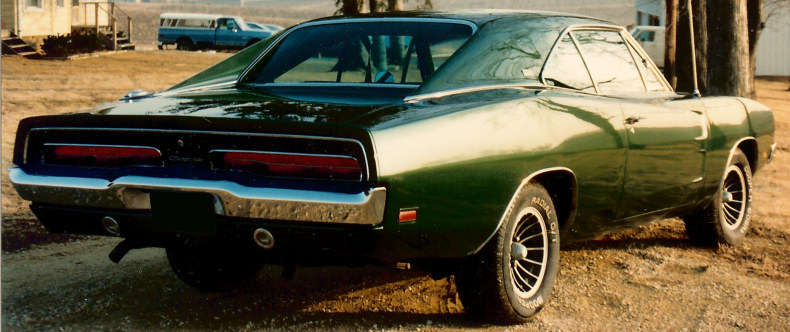


It was clear after the sales drop of the 1967 Charger that a restyle was in order. Dodge was going to restyle their entire B-body lineup for 1968 and decided that it was time to separate the Coronet and Charger models even further. What designer Richard Sias came up with was a double-diamond design that would later be referred to as coke bottle styling. From the side profile the curves around the front fenders and rear quarter panels look almost like a Coke bottle. Front and rear end sheet metal was designed by Harvey J Winn. The rear end featured a "kick up" spoiler appearance, inspired by Group 7 racing vehicles. On the roof a "flying buttress" was added to give the rear window area a look similar to that of the 1966-67 Pontiac GTO. The Charger retained its full-length hidden headlight grille, but the fully rotating electric headlights had been replaced by a simple vacuum operated cover. The full length taillights were gone as well. Instead, dual circular taillights were added at the direction of Styling Vice President, Elwood P. Engel. Dual scallops were added to the doors and hood to help accent the new swoopy lines. Inside, the interior shared almost nothing with its first generation brothers. The four bucket seats were gone, the console remained the same as the '67. The tachometer was now optional instead of standard, the trunk and grille medallions were gone, the carpeting in the trunk area was gone, replaced by a vinyl mat, the rear seats did not fold forward and the space-age looking electroluminescent gauges disappeared in favor of a more conventional looking design. In order to further boost the Charger's muscle car image, a new high-performance package was added, the R/T. This stood for "Road/Track" (no 'and' between Road and Track) and would be the high performance badge that would establish Dodge's performance image. Only the high performance cars were allowed to use the R/T badge. The R/T came standard with the previous year's 440 "Magnum" and the 426 Hemi was optional. The standard engine was the 318 2bbl until mid-year when you could order a 225 slant-six. The rest of the engine lineup (383-2, 383-4) remained unchanged. The newly reskinned "semi-fastback" design produced "probably the best looking Chargers ever offered". In 1968 Chrysler Corporation unveiled a new ad campaign featuring a Bee with an engine on its back. These cars were called the "Scat Pack". The Coronet R/T, Super Bee, Dart GTS and Charger R/T received bumble-bee stripes (two thin stripes framing two thick stripes). The stripes were standard on the R/Ts and came in red, white or black. They also could be deleted at no cost. These changes and the new Charger bodystyle proved to be very popular with the public and helped to sell 96,100 Chargers, including over 17,000 Charger R/Ts.
In 1969 not much was changed for the popular Charger. Exterior changes included a new grille with a center divider and new longitudinal taillights both designed by Harvey J. Winn. A new trim line called the Special Edition (SE) was added. This could be available by itself or packaged with the R/T, thus making an R/T-SE. The SE added leather inserts to the front seats only, chrome rocker moldings, a wood grain steering wheel and wood grain inserts on the instrument panel. A sunroof was added to the option list as well, and it would prove to be a very rare option (some 260 sold). The bumble bee stripes returned as well, but were changed slightly. Instead of four stripes it now featured one huge stripe framed by two smaller stripes. In the middle of the stripe an R/T cutout was placed. If the stripe was deleted, then a metal R/T emblem was placed where the R/T cutout was. Total production was around 89,199 units. But in 1969 Dodge had its eye on NASCAR and in order to compete it would have to create two of the most rare and desirable of all Chargers: Charger 500, and the Charger Daytona.